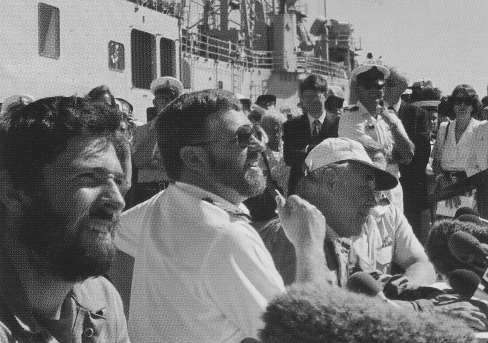- Author
- Periodical, Semaphore
- Subjects
- Ship histories and stories
- Tags
-
- RAN Ships
- HMAS Adelaide II, HMAS Westralia II
- Publication
- December 2007 edition of the Naval Historical Review (all rights reserved)
Dubois located
A RAAF Orion located Thierry Dubois in the water the same afternoon that Adelaide sailed from FBW and a few hours later a second Orion sighted the upturned hull of Exide Challenger. These aircraft not only provided information on the location of the yachts, but were able to provide immediate assistance by dropping Air Sea Rescue Kits to the distressed Dubois. Nothing could be seen of Bullimore.
For Adelaide and her crew the passage south was in itself largely uneventful with opportunities taken to work-up the embarked helicopter flight. Time was the critical factor. The tanker HMAS Westralia sailed from FBW two days later and a Liberian registered tanker MV Sanko Phoenix, possessing a heavy lift capability, stood by to assist should the need arise to either salvage or hold Exide Challenger afloat.
In the meantime, the RAAF continued to provide daylight coverage on station. Six flight crews from 10 and 11 Squadrons located at RAAF Base Edinburgh near Adelaide rotated through five Orion aircraft deployed from Perth. The aircraft flew for a total of 158 hours, providing a comforting presence for Thierry Dubois, monitoring his welfare and ensuring that he was regularly updated on the progress of the rescue operation.
Consideration was given to rescuing Dubois in the evening of 8 January; however the plan was hindered by unsuitable weather conditions and the danger that the helicopter could be threatened by icing in low cloud. At 0433 on the morning of 9 January, Adelaide launched her Seahawk for what was then a 53 nautical mile flight to Thierry Dubois’s life raft. He was winched to safety and the helicopter returned to Adelaide.
As Adelaide neared the stricken Exide Challenger, the Seahawk was again launched to conduct a photographic search of the hull, remaining in a low hover for approximately ten minutes. There was no response to the helicopter’s presence. Adelaide then circled the Exide Challenger, sounding her siren – again no response.
Bullimore rescue – that kiss!
With only one option left, Captain Gates ordered the seaboat be launched with the task of closely examining the hull of Exide Challenger prior to attempting to cut through the hull. To the surprise and relief of those there, Tony Bullimore responded to loud tapping on the hull, and appeared on the surface moments later. Leading Seaman Clearance Diver Alan Rub then proceeded to help Bullimore towards Adelaide‘s seaboat, where he was hauled in by Chief Petty Officer Peter Wicker. Images of Bullimore kissing the unsuspecting, bearded Wicker were later seen around the world.
Replenishment at sea
With Adelaide having now completed her primary task and bearing a slightly larger ship’s company, course was set for Fremantle. Westralia still had a critical role to play, replenishing Adelaide at sea on 11 January and thereby ensuring that the frigate could maintain full speed and return to the mainland with minimal delay.
Adelaide berthed in Fremantle on 13 January to a tumultuous welcome from the local populace and various dignitaries. Recovering both yachtsmen alive was a tribute to the concerted efforts of the RAN and RAAF, the search and rescue coordinators, the resilience of the two yachtsmen themselves and their sheer will to survive. Despite their trying ordeal they had coped with the onset of frostbite, hypothermia and in Bullimore’s case, a partial amputation of one of his fingers.
In spite of the euphoria engendered from the success of what was a complex and demanding search and rescue operation, celebrations amongst the wider yachting fraternity were understandably tempered in the knowledge that race officials had lost contact with a fourth competitor. Canadian Gerry Roufs in Groupe LG2, was reported lost on 8 January 1997 approximately 1600 miles west of Cape Horn. He was never found. Six months later his yacht was sighted adrift 300 miles off the coast of Chile. In September 1998, wreckage was washed up in the Straits of Magellan.

(Image:RAN)
One of the more important organisational changes implemented in the aftermath of the Southern Ocean rescues was the July 1997 amalgamation of Australia’s search and rescue coordination centres into one centralised body called Australian Search and Rescue (AusSAR).
The new organisation’s baptism of fire came 18 months later during the 1998 Sydney to Hobart Yacht Race. Cyclonic weather wrought havoc amongst the fleet north-east of Bass Strait. Six sailors perished at sea and another 55 were winched to safety by rescue helicopters. The RAN regularly tasks helicopter-capable major fleet units as Operational Response Vessels, should they be called upon to discharge Australia’s search and rescue responsibilities during these races.
Australia’s search and rescue area is one of the largest in the world, covering Australia and vast tracts of the Indian, Pacific and Southern Oceans: about a tenth of the earth’s surface. While AusSAR uses assets from the private sector, police and volunteer rescue groups for many rescues, it is often only the ADF that is able to undertake very long-range, short notice rescues in extremely demanding conditions. The capabilities inherent in naval warships and helicopters are multi-role in nature enabling navies to undertake these tasks while configured for warfighting.




